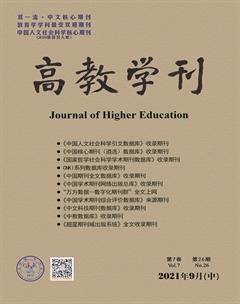脱贫攻坚背景下高校学生资助的功能定位、现实困境与实施路径研究
邹琳

摘 要:高校学生资助对脱贫攻坚作出突出贡献,是阻断贫困代际传递的重要途径。文章从价值追求、历史使命、社会意义三个方面诠释高校学生资助的功能定位。然而,当前在精准资助推进中存在粗放型资助方式、社会力量贡献不足、对“从输血到造血”诠释不足等问题。为此,亟需转变资助思维,提高政治站位,充分认识到高校学生资助在脱贫攻坚中的重大作用与意义,完善精准资助机制建设;充分发挥多元资助主体,尤其是社会主体在资助中的重要作用,加速建设社会支持体系;探索资助育人新模式,由单纯的“输血”到既“输血”又“造血”,支持学生全面发展,在脱贫攻坚中发挥更大作用。
关键词:脱贫攻坚;高校学生资助;现实困境
中图分类号:G640 文献标志码:A 文章编号:2096-000X(2021)26-0006-05
Abstract: Grants for college students have made outstanding contribution to poverty alleviation, which is a significant way to break the intergenerational transmission of poverty. This paper tries to interpret the function of grants for college students from the following three aspects: value pursuit, historical mission and social significance. However, there are still some problems in the practice of precise funding promotion, such as the extensive funding, the insufficient contribution of social groups, and the inadequate interpretation of "from blood transfusion to hematopoiesis". Therefore, it is urgent to change the thinking of financial aid, improve the political position and improve the construction of targeted funding mechanism and fully realize the important role and significance of financial aid for college students under the background of poverty alleviation. Besides, we should take maximum advantage of multiple funding entities, especially the social entities, and accelerate the construction of a social support system. We should also explore a new mode of educational subsidy, from simple "blood transfusion" to both "blood transfusion" and "blood donation", to support the all-round development of students and promote the greater role of college student subsidies in poverty alleviation.
Keywords: poverty alleviation; colleges and universities student aid; realistic dilemma
一、脫贫攻坚背景下高校学生资助的功能定位
(一)公平正义:高校学生资助的价值追求
资助工作是一项讲政治、惠民生、暖民心的工程,是构建社会主义和谐社会的重要举措。贫困问题已经不仅仅是民生问题,更影响了社会公平正义。要充分认识高校学生资助在追求社会公平正义的核心价值,更好地推动我国教育扶贫事业的改革与发展。资助不仅是为了使贫困地区和家庭经济困难学子脱离贫困,更是为了消除社会中的不平等,使全社会达到公平正义的状态,通过起点公正、过程公正和结果公正的方式实现教育分配正义和关系正义,从而实现资助对公平正义的价值追求。
十八大以来,全国在教育领域全面落实精准扶贫、精准脱贫方略,瞄准贫困地区学生,实施全覆盖的教育扶贫行动,先后实施了20项教育扶贫政策,实现了贫困地区义务教育普及、学校基础设施建设、学生资助体系、教师队伍建设、民族教育发展、职业教育提升等领域的教育扶贫全方位覆盖[1]。建立健全高校学生资助政策体系,使家庭经济困难学生都能够平等获得接受高等教育的机会,保证教育公平,实现“人人有学上,个个有技能,家家有希望”的目标,让贫困家庭子女也能拥有梦想成真和人生出彩的机会。
(二)脱贫攻坚:高校学生资助的历史使命
中共中央、国务院于2018年8月发布《中共中央国务院关于打赢脱贫攻坚战三年行动的指导意见》中提出:“到2020年,巩固脱贫成果,通过发展生产脱贫一批,易地搬迁脱贫一批,生态补偿脱贫一批,发展教育脱贫一批,社会保障兜底一批。要健全覆盖各级各类教育的资助政策体系,学生资助政策实现应助尽助。”可见,学生资助在教育扶贫中发挥着重要作用,肩负着脱贫攻坚的历史使命。

